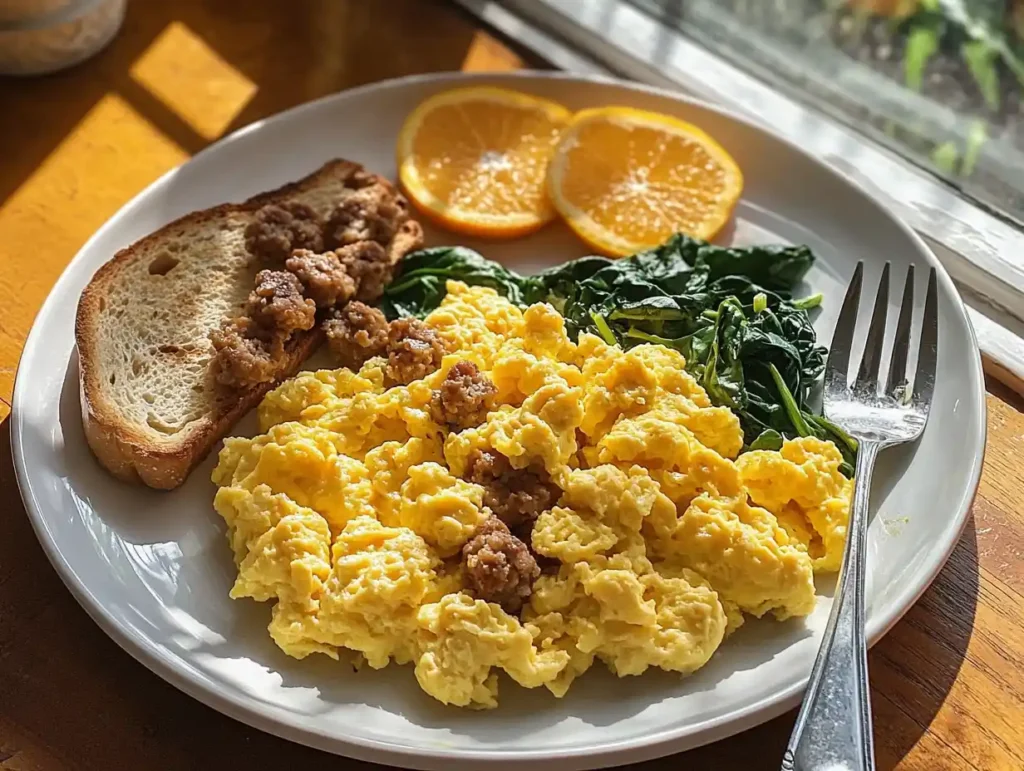Scrambled eggs are a cornerstone of breakfast around the world, celebrated for their simplicity, speed, and versatility. While scrambled eggs can stand alone as a quick and nutritious meal, adding meat takes them to a whole new level. The right meat can complement the creamy or fluffy texture of eggs with bold, savory flavors and a satisfying bite. Whether you’re incorporating crispy bacon, seasoned sausage, the addition of meat transforms scrambled eggs into a hearty, protein-packed dish perfect for any meal of the day.
But achieving the perfect balance between eggs and meat is more than just a matter of taste. The timing of when you add meat to your scrambled eggs significantly affects the texture, flavor, and overall cooking process. Should the meat go in first, giving it time to crisp up in the pan? Should it be folded in while the eggs are cooking to ensure even mixing? Or is it best to add it last, keeping the flavors distinct?
This guide explores the nuances of adding meat to scrambled eggs, helping you understand the best methods and timings for incorporating various types of meat. With the right techniques, you can elevate this humble breakfast staple into a gourmet experience. Whether you’re a beginner or an experienced cook, mastering these tips will ensure your scrambled eggs with meat turn out delicious every time.
Understanding Scrambled Eggs
What Makes Scrambled Eggs Creamy or Fluffy?
The texture of scrambled eggs depends on how they are cooked and the ingredients used. Creamy scrambled eggs require low heat, continuous stirring, and a splash of dairy, such as milk or cream. Fluffy scrambled eggs, on the other hand, rely on incorporating air into the eggs, often by whisking vigorously before cooking.
Eggs are delicate and can easily overcook, leading to a rubbery texture. Maintaining control over heat and cooking time is crucial. When you introduce add-ins like meat, it’s vital to consider how they might alter the cooking process.
Common Mistakes in Cooking Scrambled Eggs
Several errors can ruin scrambled eggs:
- High heat: This causes eggs to cook too quickly, losing their softness.
- Over-mixing: While whisking is essential, stirring too aggressively during cooking can break the eggs down into small, dry curds.
- Adding ingredients too early: Prematurely adding heavy ingredients like meat can interfere with the eggs’ ability to cook evenly.
Understanding these mistakes helps in determining the best time to add meat, ensuring both the eggs and meat are cooked perfectly.
The Role of Add-Ins in Scrambled Eggs
Add-ins are a fantastic way to enhance the flavor, texture, and nutritional profile of scrambled eggs, transforming a simple dish into a satisfying, well-rounded meal. Ingredients like meat, cheese, vegetables, and herbs introduce new layers of flavor and make the dish more versatile, suitable for any time of day. Meat, in particular, adds heartiness and a robust savory element that pairs beautifully with the creaminess of scrambled eggs. Whether you choose bacon for its crispy texture, sausage for its spice, the right meat can make scrambled eggs feel more indulgent and filling.
However, timing and preparation are critical when working with add-ins. Introducing ingredients too early can interfere with the eggs’ ability to cook evenly, while adding them too late might result in a dish that feels disjointed, with flavors that don’t meld. For example, raw meat needs to be fully cooked before mixing with eggs to ensure safety and avoid undercooked spots. On the other hand, delicate vegetables like spinach or herbs are best added near the end of cooking to preserve their color and texture.
Another key consideration is balance. Overloading scrambled eggs with too many add-ins can overshadow their natural creaminess and make the dish feel heavy. By choosing a few complementary ingredients and adding them at the right stage, you can ensure every bite is flavorful and well-balanced. The flexibility of scrambled eggs allows for endless combinations, making it easy to customize the dish to your preferences and dietary needs.
Choosing the Right Meat

Popular Meat Options for Scrambled Eggs
Different meats complement scrambled eggs in unique ways. Here are some popular choices:
- Sausage: Whether crumbled or sliced, sausage brings robust seasoning and a hearty texture.
- Turkey or chicken: These lean meats are lighter and can be seasoned to suit your preferences.
- Chorizo: A spicy, seasoned sausage that adds bold flavors and vibrant color.
Considerations for Precooked vs. Raw Meat
Using precooked meat simplifies the process, as it only needs to be reheated. For raw meat, careful preparation is necessary to ensure it is cooked thoroughly before adding it to the eggs. For instance:
- Precooked bacon: Can be crumbled and stirred in during the cooking process.
- Raw sausage: Must be browned and fully cooked separately before combining with eggs.
Health Benefits and Flavor Variations of Different Meats
The type of meat you choose can affect both the flavor and nutritional profile of your scrambled eggs.
- Sausage: High in fat and rich in flavor, ideal for indulgent breakfasts.
- Turkey: Lower in fat and calories, better for a leaner meal.
- Chorizo or other seasoned meats: Add depth and spice, great for adventurous eaters.
When to Add Meat to Scrambled Eggs
Adding Meat Before Cooking Eggs
Adding meat before cooking eggs works best with precooked options. This technique ensures that the meat is warm and evenly distributed. For example:
- Heat sausage bacon in the pan before adding the eggs.
- Warm diced meat in butter or oil before pouring in whisked eggs.
Pros:
- Meat gets infused with egg flavors.
- Ensures even mixing.
Cons:
- Risks overcooking delicate eggs if timing is not managed.
Incorporating Meat During Cooking
Adding meat during the cooking process allows you to control the texture and flavor balance. As the eggs start to set, fold in the meat gently. For instance:
- Mix cooked sausage crumbles into the eggs halfway through cooking.
- Stir in chopped, cooked chicken once the eggs have slightly firmed.
Tips:
- Use medium heat to avoid overcooking either the eggs or the meat.
- Stir gently to preserve the eggs’ fluffiness.
Adding Meat After Cooking Eggs
For a distinct layering of flavors, add meat after the eggs are fully cooked. This works particularly well with crispy bacon or shredded deli meats.
Advantages:
- Maintains the texture of both eggs and meat.
- Ideal for last-minute add-ins or when using leftover meat.
Techniques for Cooking Meat with Eggs
Preparing Raw Meat Before Mixing with Eggs
When working with raw meat, it’s essential to cook it separately before combining it with eggs to ensure safety and flavor:
- Select the right meat: Choose ground sausage, diced chicken, or crumbled chorizo for easy blending.
- Season lightly: Add salt, pepper, or spices to the meat while cooking. Avoid over-seasoning, as scrambled eggs have a subtle flavor that can be overwhelmed.
- Cook thoroughly: Ensure the meat is browned and no pink remains. Use a meat thermometer to check for a safe internal temperature (e.g., 160°F for ground beef or sausage).
- Drain excess fat: Remove grease from cooked meat to prevent soggy eggs.
Tips for Evenly Blending Cooked Meat into Scrambled Eggs
Integrating cooked meat into scrambled eggs requires attention to timing and technique:
- Chop meat into small pieces: Smaller pieces mix more evenly with eggs, creating a consistent texture.
- Warm the meat first: If precooked, heat the meat slightly before adding it to the eggs. This prevents cooling the eggs as they cook.
- Use a wide pan: A larger surface area allows for even cooking and easy mixing of eggs and meat.
- Fold gently: Stir the meat into the eggs using a spatula to avoid breaking the eggs into small, dry curds.
Seasoning Ideas for Meat and Eggs
Adding the right seasonings can elevate your scrambled eggs and meat:
- Classic flavors: Salt, black pepper, and garlic powder are versatile and enhance most meats.
- Herbs: Fresh parsley, chives, or thyme add a burst of freshness.
- Spices: Paprika, cayenne, or cumin create a smoky or spicy profile.
- Cheese pairing: Add shredded cheddar, Parmesan, or feta to complement the meat and eggs.
Pro Tip: Season in stages. Lightly season the meat as it cooks, and adjust the flavor once it’s mixed with the eggs.
Recipes and Variations

Classic Scrambled Eggs with Bacon
- Ingredients: 4 eggs, 4 strips of bacon, salt, pepper, and butter.
- Instructions:
- Cook bacon in a skillet until crispy. Remove and crumble.
- In the same pan, melt butter and pour in whisked eggs.
- Once eggs begin to set, fold in crumbled bacon.
- Season with salt and pepper, then serve immediately.
Sausage and Spinach Scrambled Eggs
- Ingredients: 4 eggs, 1 cup cooked sausage crumbles, 1 cup fresh spinach, salt, pepper, and olive oil.
- Instructions:
- Sauté spinach in olive oil until wilted. Remove and set aside.
- In the same pan, cook sausage until browned.
- Pour in whisked eggs and stir gently. Add spinach as eggs set.
- Season and serve hot.
FAQS
Can I Use Leftover Meat in Scrambled Eggs?
Yes, leftover meat works wonderfully in scrambled eggs. Simply heat the meat before adding it to the eggs to ensure even warmth throughout the dish.
How Do I Avoid Overcooking the Meat?
Cook meat on medium heat to avoid drying it out. For precooked meats, add them at the end of the cooking process to warm without overcooking.
Are There Vegetarian Substitutes for Meat in Scrambled Eggs?
Yes! Vegetarian protein options like tofu, tempeh, or plant-based sausages make excellent meat substitutes. Season them well for a similar flavor profile.
Does the Type of Pan Affect How Meat and Eggs Cook Together?
Absolutely. Non-stick pans are ideal for scrambled eggs, as they prevent sticking and require less fat. Cast iron pans retain heat well and can enhance the flavor of meat.
What Are the Best Spices to Use with Meat and Eggs?
Try paprika, cumin, cayenne, or Italian seasoning for bold flavors. Herbs like parsley, chives, or dill add a fresh touch.
Conclusion
Timing and technique play a pivotal role in creating the perfect scrambled eggs with meat. Whether you’re a fan of crispy bacon, spicy sausage, knowing when to add the meat can transform a simple dish into a culinary delight. Adding meat before cooking ensures it melds with the eggs for a rich, infused flavor, while incorporating it during or after cooking lets you retain distinct textures and flavors.
The versatility of scrambled eggs means there’s no one-size-fits-all approach. Feel free to experiment with different types of meat, seasonings, and cooking methods to create a dish that matches your preferences. Remember to balance the flavors, avoid overcooking, and use fresh, high-quality ingredients for the best results.
Whether you’re making breakfast for one or feeding a crowd, scrambled eggs with meat is a satisfying option that never goes out of style. By mastering these tips and techniques, you’ll not only elevate your breakfast game but also enjoy a meal that’s as nutritious as it is delicious. So grab your favorite skillet, pick your preferred meat, and start experimenting with this timeless breakfast favorite!
Looking to explore more ways to elevate your meals? Discover how to perfectly combine ground beef and eggs, or learn what makes mac and cheese with ground beef so satisfying. For a soup-inspired twist, find out what is the best bone for soup to complement your culinary creations!

